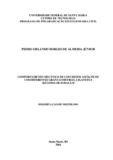| dc.creator | Almeida Júnior, Pedro Orlando Borges de | |
| dc.date.accessioned | 2016-09-06 | |
| dc.date.available | 2016-09-06 | |
| dc.date.issued | 2016-06-01 | |
| dc.identifier.citation | ALMEIDA JÚNIOR, Pedro Orlando Borges de. MECHANICAL BEHAVIOR OF ASPHALT CONCRETE WITH DIFFERENT GRANULOMETRIES, BINDERS AND DOSING METHODS. 2016. 222 f. Dissertação (Mestrado em Engenharia Civil) - Universidade Federal de Santa Maria, Santa Maria, 2016. | por |
| dc.identifier.uri | http://repositorio.ufsm.br/handle/1/7925 | |
| dc.description.abstract | The degradation of the pavement has grown considerably due to the modification
of traffic characteristics. It was increased the volume of traffic, the transported load and
the tire inflation pressure, which added to the lack of load inspection on the load transport
causes the asphalt coating the early appearance of defects. In order to seek progress on
knowledge of the behavior of asphalt mixtures this study aimed to analyze the influence
of the dosing method, of the granulometry and binders in the mechanical behavior of
asphalt mixtures and determinate which of these three variables most influence on the
mechanical behavior of the material. It was used two dosing method, Superpave and
Marshall, four granulometries, two of them determined by Bailey method (range B and
range C) and two by trial (range B and range C- simple framework on the ranges) and two
type of asphalt binders: CAP 50-70 and the CAP 60-85, totalizing sixteen asphalt
mixtures. The mixtures were evaluated in indirect tensile strength, stiffness in the resilient
modulus testing and complex modulus, which used the 2SDP1D modeling to the
composition of the master curves, and the permanent deformation by Flow Number test.
The obtained results indicated that the factor that alter the stiffness and resistance to
permanent deformation of the mixtures was the type of asphalt binder, wherein the
modified binder increased the stiffness and damage resistance of the mixtures. The Bailey
method of granulometric selection has also improved the behavior of the mixtures on a
smaller scale of influence than the type of asphalt binder, followed by the dosing method
Superpave that reduced the design binder content of the mixtures. | eng |
| dc.description.sponsorship | Coordenação de Aperfeiçoamento de Pessoal de Nível Superior | |
| dc.format | application/pdf | por |
| dc.language | por | por |
| dc.publisher | Universidade Federal de Santa Maria | por |
| dc.rights | Acesso Aberto | por |
| dc.subject | Rigidez | por |
| dc.subject | Deformação permanente | por |
| dc.subject | Módulo complexo | por |
| dc.subject | Flow number | por |
| dc.subject | Stiffness | eng |
| dc.subject | Permanent deformation | eng |
| dc.subject | Complex modulus | eng |
| dc.subject | Flow number | eng |
| dc.title | Comportamento mecânico de concretos asfálticos com diferentes granulometrias, ligantes e métodos de dosagem | por |
| dc.title.alternative | Mechanical behavior of asphalt concrete with different granulometries, binders and dosing methods | eng |
| dc.type | Dissertação | por |
| dc.description.resumo | A degradação sobre o pavimento cresceu consideravelmente em virtude da
modificação das características do tráfego. Aumentou-se o volume de tráfego, as cargas
transportadas, a pressão de inflação dos pneus, que somados a falta de fiscalização sobre
o transporte de carga ocasionam no revestimento asfáltico o surgimento precoce de
defeitos. No sentido de buscar uma evolução sobre o conhecimento do comportamento
das misturas asfálticas, este trabalho teve por objetivo analisar a influência do método de
dosagem, da granulometria e do ligante no comportamento mecânico de misturas
asfálticas e determinar quais dessas três variáveis mais influenciam no comportamento
mecânico do material. Utilizaram-se dois métodos de dosagem, Superpave e Marshall,
quatro granulometrias, duas determinadas pelo método Bailey (Faixa B e Faixa C) e duas
por tentativa (Faixa B e Faixa C- simples enquadramento nas faixas) e dois tipos de
ligantes asfálticos: CAP 50-70 e o CAP 60-85, totalizando dezesseis misturas asfálticas.
As misturas foram avaliadas na resistência à tração indireta, na rigidez pelo ensaio de
módulo de resiliência e módulo complexo, que utilizou a modelagem 2S2P1D para
composição das curvas mestras, e a deformação permanente pelo ensaio de Flow Number.
Os resultados obtidos indicaram que o fator que mais alterou a rigidez e a resistência à
deformação permanente das misturas foi o tipo de ligante asfáltico, no qual o ligante
modificado aumentou a rigidez e a resistência ao dano das misturas. O método Bailey de
seleção granulométrica também melhorou o comportamento das misturas em uma menor
escala de influência que o tipo de ligante, seguido pelo método de dosagem Superpave
que reduziu o teor de ligante de projeto das misturas. | por |
| dc.contributor.advisor1 | Cervo, Tatiana Cureau | |
| dc.contributor.advisor1Lattes | http://buscatextual.cnpq.br/buscatextual/visualizacv.do?id=K4767432H6 | por |
| dc.contributor.advisor-co1 | Specht, Luciano Pivoto | |
| dc.contributor.advisor-co1Lattes | http://lattes.cnpq.br/8038412953408618 | por |
| dc.contributor.referee1 | Soares, Jorge Barbosa | |
| dc.contributor.referee1Lattes | http://lattes.cnpq.br/9212256013670303 | por |
| dc.contributor.referee2 | Pinheiro, Rinaldo Jose Barbosa | |
| dc.contributor.referee2Lattes | http://buscatextual.cnpq.br/buscatextual/visualizacv.do?id=K4780835T4 | por |
| dc.creator.Lattes | http://lattes.cnpq.br/3229920135442077 | por |
| dc.publisher.country | BR | por |
| dc.publisher.department | Engenharia Civil | por |
| dc.publisher.initials | UFSM | por |
| dc.publisher.program | Programa de Pós-Graduação em Engenharia Civil | por |
| dc.subject.cnpq | CNPQ::ENGENHARIAS::ENGENHARIA CIVIL | por |


